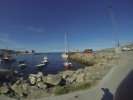Greenland 2015 - Sailing Expedition "Over Green Islands"
Leg: 15.11
Cruise rout: Upernavik - Thule - Upernavik
Upernavik – Qanaaq (Thule )– Upernavik
This cruise begins in the largest port of northern part of the Greenland Upernavik. Well connected by both sea and air, is the main starting point for many expeditions to northern Greenland. Upernavik, is famous from its world’s northernmost open-air museum. A unique wildlife dominates the Upernavik area, which also has the world’s largest bird cliff, Apparsuit. Another famous mountain is the town’s landmark, Qaarsorsuaq at 1100 metres. Hunting still plays a significant employment role in the settlements. Narwhals are still caught in the traditional way by kayak in Melville Bay, where beluga whales and polar bears are also hunted. In Greenland the hunting is tradition and it is allowed only for local needs. Not any sales nor export of meat or furs is allowed outside the Greenland area. In the harbour is a good supplies of fuel and water as well for food in the main store.
On the way from Upernavik to Thule we will possibly visit Lille Renland where we can meet reindeer or polar bears hunting seals. There are also the largest glaciers (outside of Antarctica) running downhill to the sea. We will sail around Cape York - the place where Inuit and white people met for the first time in 1818. Cape Seddon (remnants of the former settlement), Melville Bugt, Meteor Bugt, Savissivik, Morusaq are also places worth visiting.
Savissivik is the most southerly community in Avanersuaq, which lies on the south of Cap York where a 19 metre high monument to the American Explorer Robert E. Peary was erected on the cliff top. The name Savissivik means “the place where one gets iron”. The Inughuit found a number of meteorites in the area, the iron from which they used to make knives and other tools. Savissivik is another wonderful place to see icebergs.
Continuing sailing to the north we hope to reach Qaanaaq, which is a modern community with a hotel, shop, and a post office. It offers magnificent views of Inglefield Fiord with its massive Icebergs. It has a museum which is housed in the former home of the famous Arctic explorer Knud Rasmussen, named Amundsen museum. Between 1952 and May 1953, all residents of Pituffik and nearby Dundas (Uummannaq) (curent area of Thule Airbase) were forcibly relocated 130 km (81 mi) north to the new town of Qaanaaq, commonly known at the time as “New Qaanaaq” or “New Thule”.
We will explore surrounded area, visiting (depends of ice conditions):
Situated on the north coast of Robertson Fiord, only 1362 km from the North Pole, the village Siorapaluk is the most northerly natural community in the world. The most northerly settlements still remains Ny Alessund in Svalbard (Spitsbergen), however there it is only a scientist base, where during summer stay no more than 30 people of staff. Siorapaluk, which means “little Sands”, was named after the small sandy beach in front of the village
Qeqertat is small community that on an island at the bottom of Inglefield fiord, 40 NM west of Qaanaag. Once the ice is gone in summer, it is possible to see large numbers of Narwhals, which enter the fiord to feed and breed. The north and east coasts of Qeqertat Island offer magnificent views on glaciers that flow down from the icecap.
old..
And from there we will began our trip back to Upernavik, visiting other interesting places if time and weather will let us to do so.
Back to expedition

